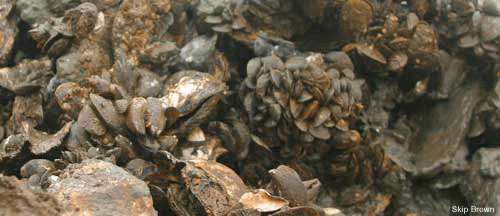What's Killing the Native Oyster?

MSX, which is caused by Haplosporidium nelsoni, is present throughout Virginia's portion of the Bay - in years of low rainfall such as the last several, higher salinities push further up the Bay into Maryland waters as does MSX virulence. The disease is often deadly above 15-20 parts per thousand salt (ocean water is 32 ppt). Recent studies by Kim Reece and Eugene Burreson at the Virginia Institute of Marine Science (VIMS) make a convincing argument that MSX arrived in the Chesapeake in the 1950s along with the Pacific oyster Crassostrea gigas that growers and researchers along the east coast were then considering for its commercial value. At the time, no one knew about MSX and for some years, scientists couldn't correctly identify its genus. (It was named MS was for the appearance of a multispheric nucleus and X for unknown.) While C. gigas may have MSX, it can fend off infections - the Bay's native oyster Crassostrea virginica cannot.
Dermo disease is the result of Perkinsus marinus, a protozoan like MSX; originally identified as the genus Dermocystidium (the shortened version has hung on), it has long been a resident in the warmer waters of the Gulf of Mexico, though over the years it has spread along the east coast and caused havoc to oyster fisheries there and elsewhere. Whether Dermo entered the Chesapeake with oysters originally brought in from the south is unknown. Regardless of how it arrived, it now persists on most public oyster grounds throughout the Bay.
|
![[Chesapeake Quarterly masthead]](/images/uploads/siteimages/imported/masthead.gif)
![[Chesapeake Quarterly masthead]](/images/uploads/siteimages/imported/masthead.gif)

![[Maryland Sea Grant]](/images/uploads/siteimages/imported/h_footer_mdsg.gif)
![[NOAA]](/images/uploads/siteimages/imported/h_footer_noaa.gif)